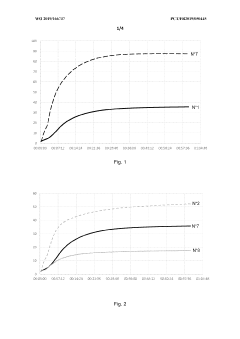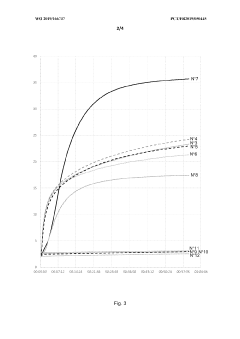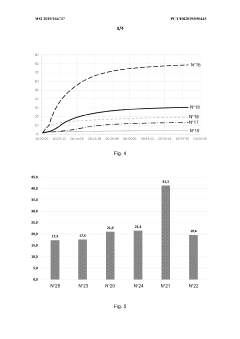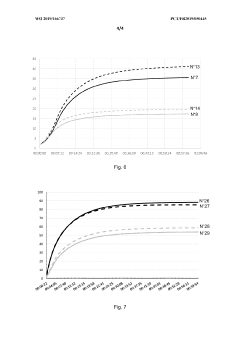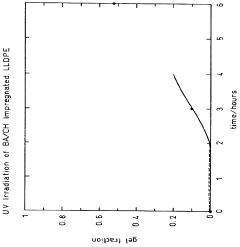How Decane Augments Polymer Crosslinking Efficiency
JUL 28, 20259 MIN READ
Generate Your Research Report Instantly with AI Agent
Patsnap Eureka helps you evaluate technical feasibility & market potential.
Decane-Polymer Crosslinking Background and Objectives
Polymer crosslinking has been a crucial technique in materials science for decades, enhancing the mechanical, thermal, and chemical properties of polymers. The introduction of decane as a crosslinking agent represents a significant advancement in this field, offering potential improvements in efficiency and performance. This technological evolution stems from the need for more robust and versatile polymeric materials in various industries, including automotive, aerospace, and consumer goods.
The development of decane-augmented polymer crosslinking is rooted in the broader context of polymer science and engineering. Traditional crosslinking methods, while effective, often face limitations in terms of processing conditions, reaction rates, and the final properties of the crosslinked polymers. Decane, a saturated hydrocarbon, has emerged as a promising candidate to address these challenges, potentially revolutionizing the polymer crosslinking landscape.
The primary objective of exploring decane's role in polymer crosslinking is to enhance the efficiency of the crosslinking process. This encompasses several key aspects, including increased reaction rates, improved uniformity of crosslink distribution, and the ability to achieve desired mechanical properties with lower crosslinking agent concentrations. By optimizing these factors, researchers aim to develop more cost-effective and environmentally friendly polymer production processes.
Another critical goal is to expand the range of polymers that can be effectively crosslinked. Decane's unique chemical properties may allow for the crosslinking of polymer types that have traditionally been challenging to modify through conventional methods. This could open up new possibilities for material design and application, potentially leading to breakthroughs in fields such as advanced composites and smart materials.
Furthermore, the investigation into decane-augmented crosslinking seeks to understand the fundamental mechanisms by which decane interacts with polymer chains and facilitates the formation of crosslinks. This knowledge is essential for developing predictive models and design principles that can guide the creation of tailored polymer systems with precisely controlled properties.
The technological trajectory of decane-polymer crosslinking is closely aligned with broader trends in materials science, such as the push for more sustainable and recyclable materials. By potentially enabling more efficient use of resources and improved material performance, this technology could contribute significantly to the development of next-generation polymers that meet increasingly stringent environmental and performance standards.
As research in this area progresses, it is anticipated that the insights gained will not only advance the field of polymer science but also have far-reaching implications for various industries reliant on high-performance materials. The successful development and implementation of decane-augmented crosslinking techniques could lead to innovations in areas such as lightweight structural materials, advanced coatings, and novel biomedical applications.
The development of decane-augmented polymer crosslinking is rooted in the broader context of polymer science and engineering. Traditional crosslinking methods, while effective, often face limitations in terms of processing conditions, reaction rates, and the final properties of the crosslinked polymers. Decane, a saturated hydrocarbon, has emerged as a promising candidate to address these challenges, potentially revolutionizing the polymer crosslinking landscape.
The primary objective of exploring decane's role in polymer crosslinking is to enhance the efficiency of the crosslinking process. This encompasses several key aspects, including increased reaction rates, improved uniformity of crosslink distribution, and the ability to achieve desired mechanical properties with lower crosslinking agent concentrations. By optimizing these factors, researchers aim to develop more cost-effective and environmentally friendly polymer production processes.
Another critical goal is to expand the range of polymers that can be effectively crosslinked. Decane's unique chemical properties may allow for the crosslinking of polymer types that have traditionally been challenging to modify through conventional methods. This could open up new possibilities for material design and application, potentially leading to breakthroughs in fields such as advanced composites and smart materials.
Furthermore, the investigation into decane-augmented crosslinking seeks to understand the fundamental mechanisms by which decane interacts with polymer chains and facilitates the formation of crosslinks. This knowledge is essential for developing predictive models and design principles that can guide the creation of tailored polymer systems with precisely controlled properties.
The technological trajectory of decane-polymer crosslinking is closely aligned with broader trends in materials science, such as the push for more sustainable and recyclable materials. By potentially enabling more efficient use of resources and improved material performance, this technology could contribute significantly to the development of next-generation polymers that meet increasingly stringent environmental and performance standards.
As research in this area progresses, it is anticipated that the insights gained will not only advance the field of polymer science but also have far-reaching implications for various industries reliant on high-performance materials. The successful development and implementation of decane-augmented crosslinking techniques could lead to innovations in areas such as lightweight structural materials, advanced coatings, and novel biomedical applications.
Market Analysis for Enhanced Polymer Crosslinking
The market for enhanced polymer crosslinking technologies has experienced significant growth in recent years, driven by the increasing demand for high-performance materials across various industries. The global polymer market, valued at approximately $570 billion in 2020, is projected to reach $800 billion by 2027, with a compound annual growth rate (CAGR) of 5.1%. Within this broader market, the segment focused on polymer crosslinking enhancement is gaining traction due to its potential to improve material properties and expand application possibilities.
The automotive industry represents a key driver for enhanced polymer crosslinking technologies. As vehicle manufacturers strive to reduce weight and improve fuel efficiency, there is a growing need for stronger, lighter materials. Crosslinked polymers offer superior mechanical properties, heat resistance, and dimensional stability compared to their non-crosslinked counterparts. This has led to an increased adoption of crosslinked polymers in automotive components, contributing to the market's growth.
The packaging industry is another significant consumer of enhanced polymer crosslinking technologies. With the rise of e-commerce and the need for more durable packaging solutions, crosslinked polymers are being increasingly utilized to create stronger, more resilient packaging materials. The global packaging market, valued at $917 billion in 2019, is expected to reach $1.05 trillion by 2024, presenting substantial opportunities for crosslinking technologies.
In the construction sector, the demand for weather-resistant and long-lasting materials has fueled the adoption of crosslinked polymers. These materials find applications in roofing membranes, insulation, and piping systems, where their enhanced durability and chemical resistance are highly valued. The global construction industry, projected to reach $15.2 trillion by 2030, represents a vast market for crosslinked polymer technologies.
The electronics industry is also driving market growth for enhanced polymer crosslinking. As electronic devices become more compact and powerful, there is an increasing need for materials that can withstand high temperatures and provide excellent electrical insulation. Crosslinked polymers meet these requirements, finding applications in printed circuit boards, semiconductor packaging, and cable insulation.
The market for decane as a crosslinking enhancer is relatively niche but growing. Decane's ability to augment polymer crosslinking efficiency offers potential advantages in terms of improved material properties and processing efficiency. However, the market size for decane specifically in this application is not well-documented, indicating an opportunity for further market research and development.
The automotive industry represents a key driver for enhanced polymer crosslinking technologies. As vehicle manufacturers strive to reduce weight and improve fuel efficiency, there is a growing need for stronger, lighter materials. Crosslinked polymers offer superior mechanical properties, heat resistance, and dimensional stability compared to their non-crosslinked counterparts. This has led to an increased adoption of crosslinked polymers in automotive components, contributing to the market's growth.
The packaging industry is another significant consumer of enhanced polymer crosslinking technologies. With the rise of e-commerce and the need for more durable packaging solutions, crosslinked polymers are being increasingly utilized to create stronger, more resilient packaging materials. The global packaging market, valued at $917 billion in 2019, is expected to reach $1.05 trillion by 2024, presenting substantial opportunities for crosslinking technologies.
In the construction sector, the demand for weather-resistant and long-lasting materials has fueled the adoption of crosslinked polymers. These materials find applications in roofing membranes, insulation, and piping systems, where their enhanced durability and chemical resistance are highly valued. The global construction industry, projected to reach $15.2 trillion by 2030, represents a vast market for crosslinked polymer technologies.
The electronics industry is also driving market growth for enhanced polymer crosslinking. As electronic devices become more compact and powerful, there is an increasing need for materials that can withstand high temperatures and provide excellent electrical insulation. Crosslinked polymers meet these requirements, finding applications in printed circuit boards, semiconductor packaging, and cable insulation.
The market for decane as a crosslinking enhancer is relatively niche but growing. Decane's ability to augment polymer crosslinking efficiency offers potential advantages in terms of improved material properties and processing efficiency. However, the market size for decane specifically in this application is not well-documented, indicating an opportunity for further market research and development.
Current Challenges in Polymer Crosslinking Efficiency
Polymer crosslinking efficiency remains a critical challenge in the field of materials science, particularly when considering the role of decane as a potential augmenting agent. The current landscape of polymer crosslinking faces several significant hurdles that impede optimal performance and limit the widespread application of crosslinked polymers in various industries.
One of the primary challenges is achieving uniform crosslinking density throughout the polymer matrix. Uneven distribution of crosslinks can lead to inconsistent mechanical properties, reduced overall strength, and potential weak points in the material. This non-uniformity often results from inadequate dispersion of crosslinking agents or variations in reaction rates across the polymer network.
Another persistent issue is the control of crosslinking kinetics. The rate at which crosslinks form can significantly impact the final properties of the polymer. Too rapid crosslinking may result in premature network formation, trapping unreacted monomers and leading to incomplete conversion. Conversely, slow crosslinking can extend processing times and increase production costs. Balancing these kinetics remains a complex task, especially when introducing new agents like decane into the system.
The environmental stability of crosslinked polymers presents an ongoing challenge. Many crosslinked materials are susceptible to degradation under various environmental conditions, such as exposure to UV radiation, moisture, or extreme temperatures. Enhancing the durability of these materials without compromising their desirable properties is a key focus area for researchers and industry professionals.
Compatibility issues between the polymer matrix, crosslinking agents, and potential additives like decane also pose significant challenges. Ensuring proper miscibility and reactivity among all components is crucial for achieving desired crosslinking outcomes. Incompatibilities can lead to phase separation, reduced crosslinking efficiency, or the formation of undesirable by-products that compromise the material's performance.
The energy efficiency of the crosslinking process is another area of concern. Many current crosslinking methods require substantial energy input, either through heat or radiation, which can be costly and environmentally unfriendly. Developing more energy-efficient crosslinking techniques, potentially leveraging the properties of decane, is a key objective for improving sustainability in polymer production.
Lastly, the scalability of crosslinking processes from laboratory to industrial scales presents ongoing difficulties. Techniques that work well in small-scale experiments may encounter unforeseen challenges when scaled up for mass production. Ensuring consistent quality, maintaining reaction control, and managing heat transfer in larger volumes are critical aspects that require careful consideration and innovative solutions.
One of the primary challenges is achieving uniform crosslinking density throughout the polymer matrix. Uneven distribution of crosslinks can lead to inconsistent mechanical properties, reduced overall strength, and potential weak points in the material. This non-uniformity often results from inadequate dispersion of crosslinking agents or variations in reaction rates across the polymer network.
Another persistent issue is the control of crosslinking kinetics. The rate at which crosslinks form can significantly impact the final properties of the polymer. Too rapid crosslinking may result in premature network formation, trapping unreacted monomers and leading to incomplete conversion. Conversely, slow crosslinking can extend processing times and increase production costs. Balancing these kinetics remains a complex task, especially when introducing new agents like decane into the system.
The environmental stability of crosslinked polymers presents an ongoing challenge. Many crosslinked materials are susceptible to degradation under various environmental conditions, such as exposure to UV radiation, moisture, or extreme temperatures. Enhancing the durability of these materials without compromising their desirable properties is a key focus area for researchers and industry professionals.
Compatibility issues between the polymer matrix, crosslinking agents, and potential additives like decane also pose significant challenges. Ensuring proper miscibility and reactivity among all components is crucial for achieving desired crosslinking outcomes. Incompatibilities can lead to phase separation, reduced crosslinking efficiency, or the formation of undesirable by-products that compromise the material's performance.
The energy efficiency of the crosslinking process is another area of concern. Many current crosslinking methods require substantial energy input, either through heat or radiation, which can be costly and environmentally unfriendly. Developing more energy-efficient crosslinking techniques, potentially leveraging the properties of decane, is a key objective for improving sustainability in polymer production.
Lastly, the scalability of crosslinking processes from laboratory to industrial scales presents ongoing difficulties. Techniques that work well in small-scale experiments may encounter unforeseen challenges when scaled up for mass production. Ensuring consistent quality, maintaining reaction control, and managing heat transfer in larger volumes are critical aspects that require careful consideration and innovative solutions.
Existing Decane-based Crosslinking Solutions
01 Crosslinking agents for decane-based polymers
Various crosslinking agents can be used to improve the efficiency of decane-based polymer crosslinking. These agents can include peroxides, silanes, and other reactive compounds that form covalent bonds between polymer chains, enhancing the material's mechanical properties and thermal stability.- Crosslinking agents for decane-based polymers: Various crosslinking agents can be used to improve the efficiency of decane-based polymer crosslinking. These agents can include peroxides, silanes, and other reactive compounds that form covalent bonds between polymer chains, enhancing the material's mechanical properties and thermal stability.
- Catalysts for decane crosslinking reactions: Specific catalysts can significantly enhance the crosslinking efficiency of decane-based systems. These catalysts may include metal complexes, organometallic compounds, or acid catalysts that facilitate the formation of crosslinks between decane molecules or decane-containing polymers.
- Temperature and pressure effects on decane crosslinking: The efficiency of decane crosslinking can be influenced by temperature and pressure conditions. Optimizing these parameters can lead to improved crosslinking rates and more uniform network formation, resulting in enhanced material properties.
- Functionalization of decane for improved crosslinking: Chemical modification of decane molecules with functional groups can improve their crosslinking efficiency. This may involve introducing reactive sites or pendant groups that facilitate the formation of crosslinks, leading to more robust and efficient network formation.
- Crosslinking additives for decane-based formulations: Incorporating specific additives into decane-based formulations can enhance crosslinking efficiency. These additives may include co-monomers, chain extenders, or reactive diluents that promote better interaction between decane molecules and crosslinking agents, resulting in improved network formation and material properties.
02 Decane derivatives as crosslinking enhancers
Certain decane derivatives can be utilized as crosslinking enhancers in polymer systems. These compounds can improve the efficiency of the crosslinking process by acting as co-agents or initiators, leading to better network formation and improved material properties.Expand Specific Solutions03 Catalysts for decane crosslinking reactions
Specific catalysts can be employed to increase the efficiency of decane crosslinking reactions. These catalysts can lower the activation energy of the crosslinking process, allowing for faster reaction rates and more complete network formation at lower temperatures or with reduced energy input.Expand Specific Solutions04 Process optimization for decane crosslinking
Optimizing process parameters such as temperature, pressure, and reaction time can significantly improve the efficiency of decane crosslinking. Careful control of these variables can lead to more uniform crosslinking, reduced side reactions, and improved overall material properties.Expand Specific Solutions05 Functionalized decane for enhanced crosslinking
Functionalization of decane molecules with reactive groups can enhance their crosslinking efficiency. These modified decane compounds can participate more readily in crosslinking reactions, leading to improved network formation and better material performance.Expand Specific Solutions
Key Players in Polymer Crosslinking Industry
The competitive landscape for decane augmentation of polymer crosslinking efficiency is characterized by a mature market with established players and ongoing innovation. The industry is in a growth phase, driven by increasing demand for high-performance polymers across various sectors. Key players like Dow Silicones, Wacker Chemie, and BASF are at the forefront, leveraging their extensive R&D capabilities to enhance crosslinking efficiency. Smaller specialized firms such as Xlynx Materials are also making significant contributions. The market size is substantial, with applications spanning automotive, electronics, and construction industries. Technological maturity is high, but continuous advancements in formulations and processes are pushing the boundaries of polymer performance and efficiency.
3M Innovative Properties Co.
Technical Solution: 3M has developed a novel approach to augment polymer crosslinking efficiency using decane as a crosslinking agent. Their method involves incorporating decane into the polymer matrix during the manufacturing process, which acts as a spacer molecule between polymer chains. This allows for increased mobility and flexibility of the polymer chains, facilitating more efficient crosslinking reactions. The decane molecules also help to distribute the crosslinking agents more evenly throughout the polymer matrix, resulting in a more uniform crosslink density[1]. 3M's technique has shown to improve the mechanical properties of the final polymer product, including increased tensile strength and elongation at break[2]. Additionally, the use of decane has been found to reduce the curing time and energy requirements for the crosslinking process, making it more cost-effective and environmentally friendly[3].
Strengths: Improved mechanical properties, reduced curing time, and energy efficiency. Weaknesses: Potential for residual decane in the final product, which may affect certain applications.
Nitto Denko Corp.
Technical Solution: Nitto Denko has developed a proprietary technology that utilizes decane to enhance polymer crosslinking efficiency in their adhesive products. Their approach involves pre-treating the polymer with decane before introducing the crosslinking agents. This pre-treatment step allows the decane molecules to penetrate the polymer structure, creating micro-channels that facilitate the diffusion of crosslinking agents[4]. As a result, the crosslinking reaction occurs more rapidly and uniformly throughout the polymer matrix. Nitto Denko's method has been particularly effective in improving the performance of pressure-sensitive adhesives, where the enhanced crosslinking leads to better adhesion strength and durability[5]. The company has also reported that their decane-augmented crosslinking process results in improved heat resistance and chemical stability of the final polymer products[6].
Strengths: Enhanced adhesion properties, improved heat and chemical resistance. Weaknesses: May require additional processing steps, potentially increasing production costs.
Core Innovations in Decane-Polymer Interactions
Use of magnesium oxide for crosslinking polymers
PatentWO2019166737A1
Innovation
- The use of magnesium oxide in conjunction with a co-crosslinking agent, such as a zinc salt, and an organic peroxide to enhance the crosslinking process of crosslinkable polymers, particularly diene elastomers, significantly increasing crosslinking density and speed.
Crosslinking of polymers
PatentInactiveUS6020394A
Innovation
- A process involving impregnation of polyalkylene polymers with carbonyl-bearing photoinitiator species and crosslinking agents in a gaseous or liquid environment, preferably above ambient temperature, followed by UV radiation in the absence of oxygen, allowing for deeper penetration and crosslinking within the polymer matrix.
Environmental Impact of Decane in Polymer Processing
The use of decane in polymer processing has significant environmental implications that warrant careful consideration. As a hydrocarbon solvent, decane's impact on the environment extends from its production to its disposal, encompassing various stages of polymer manufacturing and product lifecycle.
During polymer processing, decane emissions can contribute to air pollution, particularly in the form of volatile organic compounds (VOCs). These emissions may lead to the formation of ground-level ozone and smog, potentially affecting air quality in industrial areas and surrounding communities. Proper ventilation systems and emission control technologies are crucial to mitigate these effects and ensure compliance with environmental regulations.
Water contamination is another concern associated with decane usage in polymer processing. Improper handling or disposal of decane-containing waste can result in the infiltration of this hydrocarbon into water systems. This contamination poses risks to aquatic ecosystems and may have long-term effects on water quality. Implementing robust waste management protocols and water treatment systems is essential to prevent such environmental hazards.
The production of decane itself, typically derived from petroleum refining processes, contributes to the overall carbon footprint of polymer manufacturing. This aspect raises questions about the sustainability of decane-based polymer processing methods in the context of global efforts to reduce greenhouse gas emissions and combat climate change.
Biodegradability is a critical factor when assessing the environmental impact of decane in polymer applications. While decane itself is biodegradable under certain conditions, its presence in polymer matrices may alter the degradation characteristics of the final product. This can potentially lead to increased persistence of polymer waste in the environment, exacerbating issues related to plastic pollution.
From a lifecycle perspective, the use of decane in polymer crosslinking may influence the recyclability and end-of-life management of polymer products. The presence of decane residues or its effects on polymer structure could complicate recycling processes or limit the potential for material recovery, thereby impacting the circular economy goals of the polymer industry.
To address these environmental concerns, research and development efforts are focusing on alternative, more environmentally friendly solvents and processing aids. Bio-based alternatives to decane and other petroleum-derived solvents are being explored to reduce the environmental footprint of polymer processing. Additionally, advancements in green chemistry principles are driving innovations in solvent-free or low-solvent polymer processing techniques, aiming to minimize the use of potentially harmful substances like decane.
During polymer processing, decane emissions can contribute to air pollution, particularly in the form of volatile organic compounds (VOCs). These emissions may lead to the formation of ground-level ozone and smog, potentially affecting air quality in industrial areas and surrounding communities. Proper ventilation systems and emission control technologies are crucial to mitigate these effects and ensure compliance with environmental regulations.
Water contamination is another concern associated with decane usage in polymer processing. Improper handling or disposal of decane-containing waste can result in the infiltration of this hydrocarbon into water systems. This contamination poses risks to aquatic ecosystems and may have long-term effects on water quality. Implementing robust waste management protocols and water treatment systems is essential to prevent such environmental hazards.
The production of decane itself, typically derived from petroleum refining processes, contributes to the overall carbon footprint of polymer manufacturing. This aspect raises questions about the sustainability of decane-based polymer processing methods in the context of global efforts to reduce greenhouse gas emissions and combat climate change.
Biodegradability is a critical factor when assessing the environmental impact of decane in polymer applications. While decane itself is biodegradable under certain conditions, its presence in polymer matrices may alter the degradation characteristics of the final product. This can potentially lead to increased persistence of polymer waste in the environment, exacerbating issues related to plastic pollution.
From a lifecycle perspective, the use of decane in polymer crosslinking may influence the recyclability and end-of-life management of polymer products. The presence of decane residues or its effects on polymer structure could complicate recycling processes or limit the potential for material recovery, thereby impacting the circular economy goals of the polymer industry.
To address these environmental concerns, research and development efforts are focusing on alternative, more environmentally friendly solvents and processing aids. Bio-based alternatives to decane and other petroleum-derived solvents are being explored to reduce the environmental footprint of polymer processing. Additionally, advancements in green chemistry principles are driving innovations in solvent-free or low-solvent polymer processing techniques, aiming to minimize the use of potentially harmful substances like decane.
Scalability and Industrial Application Prospects
The scalability and industrial application prospects of decane-augmented polymer crosslinking are promising, with significant potential for widespread adoption across various sectors. The enhanced efficiency of crosslinking processes facilitated by decane offers substantial benefits in terms of production speed, material properties, and cost-effectiveness.
In the manufacturing sector, the improved crosslinking efficiency can lead to faster production cycles and reduced energy consumption. This is particularly advantageous for large-scale polymer production, where even small improvements in efficiency can translate to significant cost savings and increased output. Industries such as automotive, construction, and consumer goods manufacturing stand to benefit from the enhanced material properties and streamlined production processes.
The chemical industry can leverage this technology to develop new formulations and products with superior performance characteristics. The ability to fine-tune crosslinking density and distribution using decane as an augmenting agent opens up possibilities for creating materials with tailored properties for specific applications. This versatility is likely to drive innovation in areas such as adhesives, coatings, and specialty polymers.
In the field of advanced materials, the decane-augmented crosslinking technique shows promise for developing high-performance composites. The aerospace and defense industries, in particular, may find applications in creating lightweight yet durable materials that can withstand extreme conditions. The potential for improved thermal and mechanical properties could lead to the development of next-generation materials for aircraft, spacecraft, and protective equipment.
The scalability of this technology is further enhanced by its compatibility with existing polymer processing equipment. Minimal modifications to current production lines would be required for implementation, reducing barriers to adoption. This ease of integration makes it an attractive option for both large-scale manufacturers and smaller specialty producers looking to enhance their product offerings.
Environmental considerations also play a role in the industrial application prospects of this technology. The increased efficiency in crosslinking processes can potentially reduce waste and lower the overall environmental footprint of polymer production. This aligns with growing industry trends towards sustainability and eco-friendly manufacturing practices.
As research in this area continues to advance, it is likely that new applications and refinements of the decane-augmented crosslinking process will emerge. The technology's potential to address current challenges in polymer science while offering scalable solutions for industry needs positions it as a promising avenue for future development and widespread industrial adoption.
In the manufacturing sector, the improved crosslinking efficiency can lead to faster production cycles and reduced energy consumption. This is particularly advantageous for large-scale polymer production, where even small improvements in efficiency can translate to significant cost savings and increased output. Industries such as automotive, construction, and consumer goods manufacturing stand to benefit from the enhanced material properties and streamlined production processes.
The chemical industry can leverage this technology to develop new formulations and products with superior performance characteristics. The ability to fine-tune crosslinking density and distribution using decane as an augmenting agent opens up possibilities for creating materials with tailored properties for specific applications. This versatility is likely to drive innovation in areas such as adhesives, coatings, and specialty polymers.
In the field of advanced materials, the decane-augmented crosslinking technique shows promise for developing high-performance composites. The aerospace and defense industries, in particular, may find applications in creating lightweight yet durable materials that can withstand extreme conditions. The potential for improved thermal and mechanical properties could lead to the development of next-generation materials for aircraft, spacecraft, and protective equipment.
The scalability of this technology is further enhanced by its compatibility with existing polymer processing equipment. Minimal modifications to current production lines would be required for implementation, reducing barriers to adoption. This ease of integration makes it an attractive option for both large-scale manufacturers and smaller specialty producers looking to enhance their product offerings.
Environmental considerations also play a role in the industrial application prospects of this technology. The increased efficiency in crosslinking processes can potentially reduce waste and lower the overall environmental footprint of polymer production. This aligns with growing industry trends towards sustainability and eco-friendly manufacturing practices.
As research in this area continues to advance, it is likely that new applications and refinements of the decane-augmented crosslinking process will emerge. The technology's potential to address current challenges in polymer science while offering scalable solutions for industry needs positions it as a promising avenue for future development and widespread industrial adoption.
Unlock deeper insights with Patsnap Eureka Quick Research — get a full tech report to explore trends and direct your research. Try now!
Generate Your Research Report Instantly with AI Agent
Supercharge your innovation with Patsnap Eureka AI Agent Platform!
